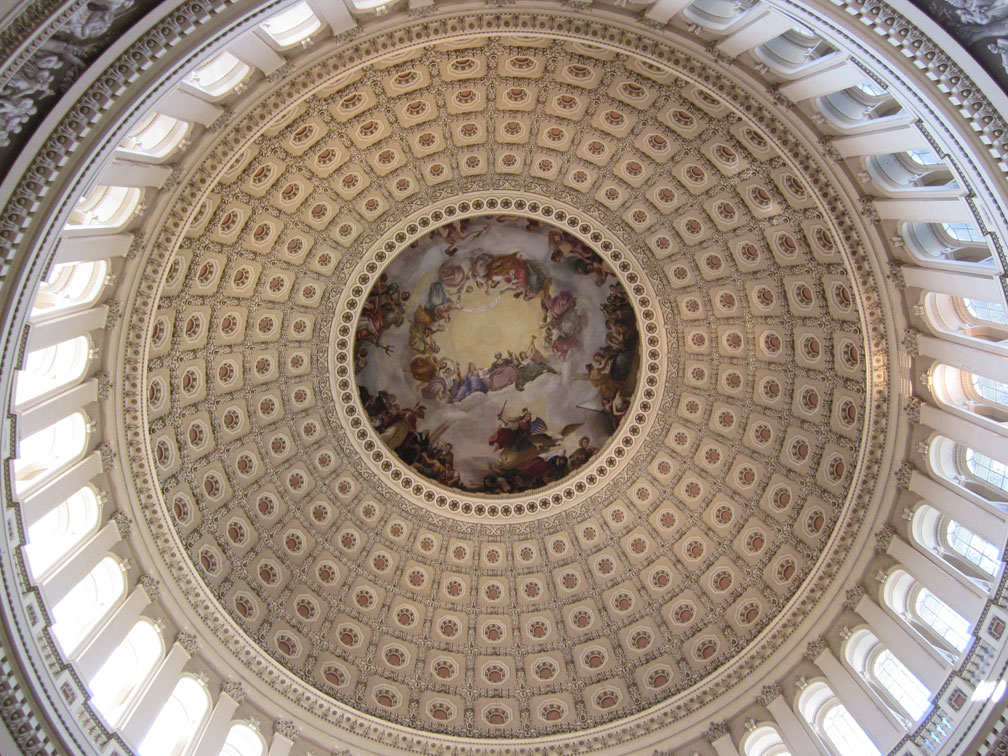

Central Dome above a Rotunda
United States Capitol
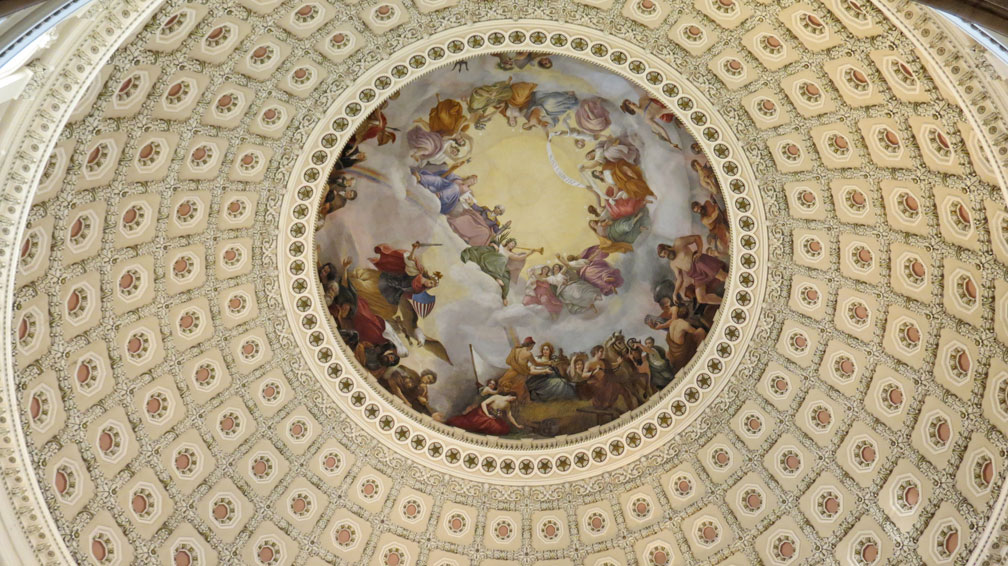
1863 dome
The 1850 expansion more than doubled the length of the Capitol, dwarfing the original, timber-framed 1818 dome. In 1855, the decision was made to tear it down and replace it with the "wedding-cake style" cast-iron dome that stands today. Also designed by Walter, the new dome stood three times the height of the original dome and 100 feet (30 m) in diameter, yet had to be supported on the existing masonry piers. Like Mansart's dome at Les Invalides (which he had visited in 1838), Walter's dome is double, with a large oculus in the inner dome, through which is seen The Apotheosis of Washington painted on a shell suspended from the supporting ribs, which also support the visible exterior structure and the tholos that supports Freedom, a colossal statue that was added to the top of the dome in 1863. The weight of the cast iron for the dome has been published as 8,909,200 pounds (4,041,100 kg).
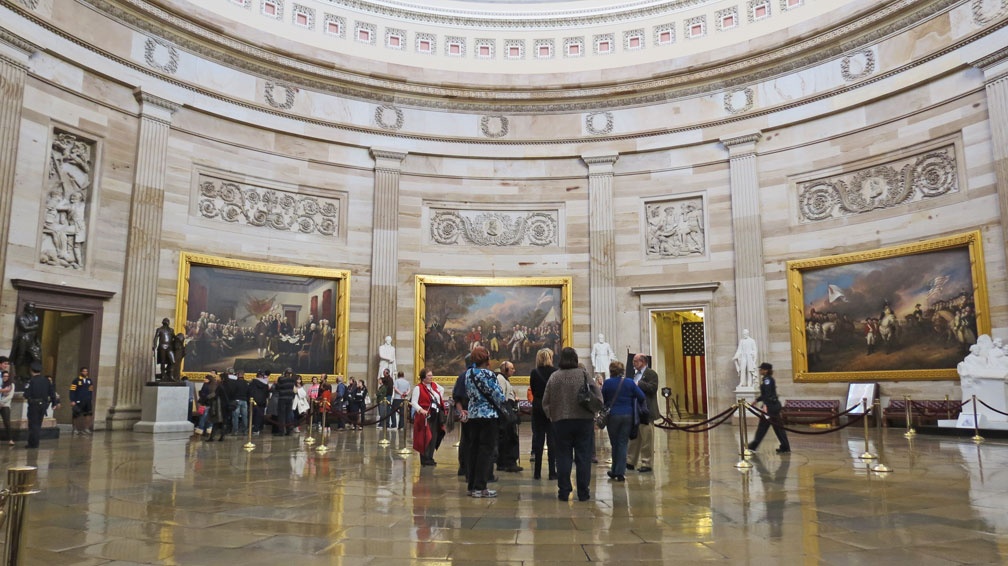
When the Capitol's new dome was finally completed, its massive visual weight, in
turn, overpowered the proportions of the columns of the East Portico, built in
1828. The East Front of the Capitol building was rebuilt in 1904, following a
design of the architects Carrère and Hastings, who also designed the Senate and
House office buildings.

The next major expansion to the Capitol started in 1958, with a 33.5 feet (10.2
m) extension of the East Portico. During this project, the dome underwent its
last restoration. A marble duplicate of the sandstone East Front was built 33.5
feet (10.2 m) from the old Front. (In 1962, a connecting extension incorporated
what formerly was an outside wall as an inside wall.) In the process, the
Corinthian columns were removed. It was not until 1984 that landscape designer
Russell Page created a suitable setting for them in a large meadow at the
National Arboretum as the National Capitol Columns, where they are combined with
a reflecting pool in an ensemble that reminds some visitors of Persepolis.
Besides the columns, hundreds of blocks of the original stone were removed and
are stored behind a National Park Service maintenance yard in Rock Creek Park.
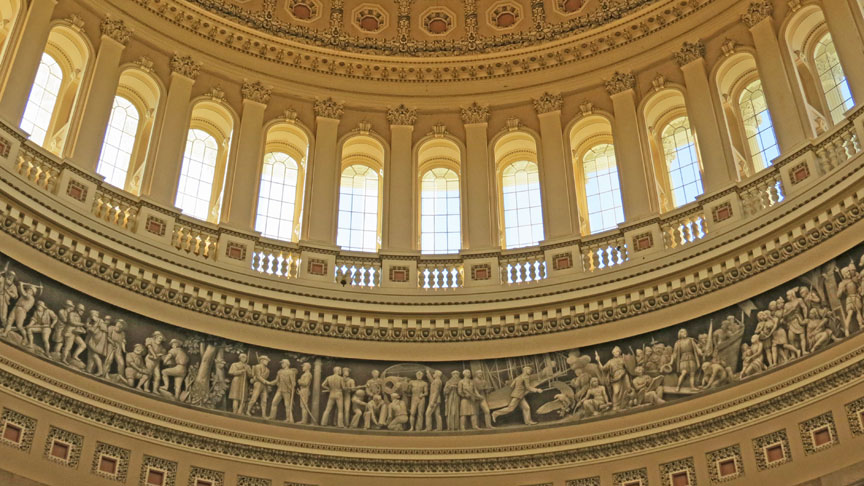
On December 19, 1960, the Capitol was declared a National Historic Landmark by
the National Park Service. The building was ranked No.6 in a 2007 survey
conducted for the American Institute of Architects' list of "America's Favorite
Architecture". The Capitol draws heavily from other notable buildings,
especially churches and landmarks in Europe, including the dome of St. Peter's
Basilica in the Vatican and St. Paul's Cathedral in London. On the roofs of the
Senate and House Chambers are flagpoles that fly the U.S. flag when either is in
session. On September 18, 1993, to commemorate the Capitol's bicentennial, the
Masonic ritual cornerstone laying with George Washington was reenacted. Strom
Thurmond was one of the Freemason politicians who took part in the ceremony.
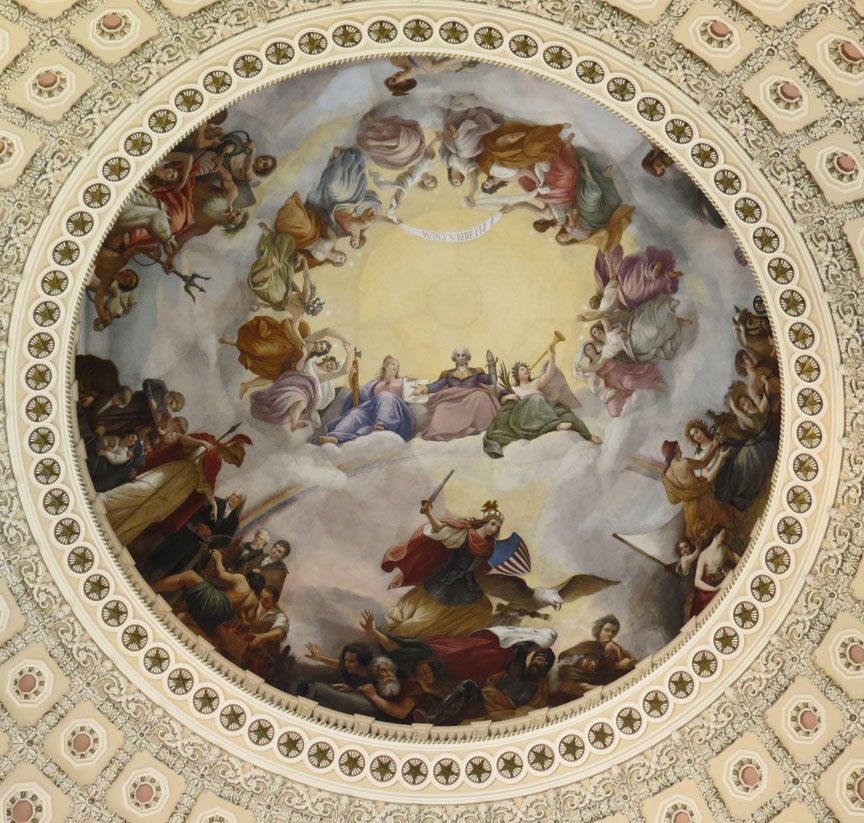
the Apotheosis of Washington
The fresco painted on the interior of the Capitol's dome titled The Apotheosis of Washington was painted by Constantino Brumidi in 1865

The Capitol building is marked by its central dome above a rotunda and two wings, one for each chamber of Congress: the north wing is the Senate chamber and the south wing is the House of Representatives chamber. Above these chambers are galleries where visitors can watch the Senate and House of Representatives. It is an example of the neoclassical architecture style. The statue on top of the dome is the Statue of Freedom.
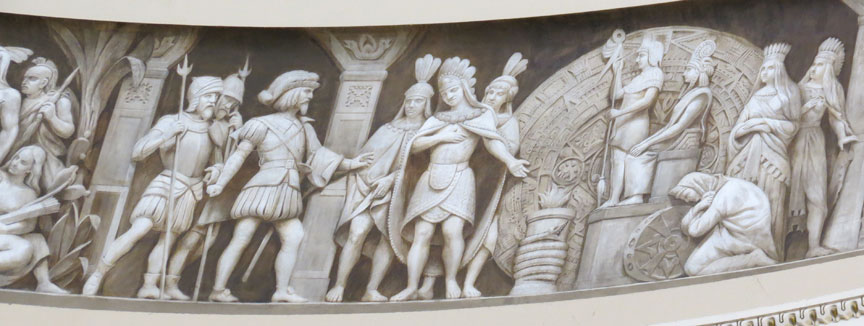
Cortez and Montezuma at Mexican Temple
Underground tunnels and a private subway connect the main Capitol building with each of the Congressional office buildings in the surrounding complex. All rooms in the Capitol are designated as either S (for Senate) or H (for House), depending on whether they are north (Senate) or south (House) of the Rotunda. Additionally, all addresses in Washington, D.C. are designated NE, NW, SE, or SW, in relation to the Rotunda. Since the Capitol Rotunda is not located in the center of the District—it is slightly farther east and south—the four D.C. quadrants are not the same shape and size.

Landing of Columbus
The Capitol has a long history in art of the United States, beginning in 1856 with Italian/Greek American artist Constantino Brumidi and his murals in the hallways of the first floor of the Senate side of the Capitol. The murals, known as the Brumidi Corridors, reflect great moments and people in United States history. Among the original works are those depicting Benjamin Franklin, John Fitch, Robert Fulton, and events such as the Cession of Louisiana. Also decorating the walls are animals, insects and natural flora indigenous to the United States. Brumidi's design left many spaces open so that future events in United States history could be added. Among those added are the Spirit of St. Louis, the Moon landing, and the Challenger shuttle crew.
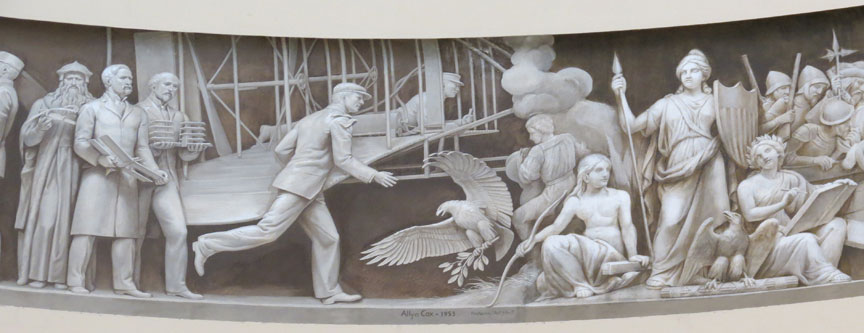
The Birth of Aviation
Brumidi also worked within the Rotunda. He is responsible for the painting of The Apotheosis of Washington beneath the top of the dome, and also the famous Frieze of United States History. The Apotheosis of Washington was completed in 11 months and painted by Brumidi while suspended nearly 180 feet (55 m) in the air. It is said to be the first attempt by the United States to deify a founding father. Washington is depicted surrounded by 13 maidens in an inner ring with many Greek and Roman gods and goddesses below him in a second ring. The frieze is located around the inside of the base of the dome and is a chronological, pictorial history of the United States from the landing of Christopher Columbus to the Wright Brothers's flight in Kitty Hawk, North Carolina. The frieze was started in 1878 and was not completed until 1953. The frieze was therefore painted by four different artists: Brumidi, Filippo Costaggini, Charles Ayer Whipple, and Allyn Cox. The final scenes depicted in the fresco had not yet occurred when Brumidi began his Frieze of the United States History.
Text from Wikipedia

Naval Gun Crew in the Spanish-American War
A group of United States Navy sailors in a gun crew are depicted in a naval battle during the Spanish–American War. and the United States won a victory over Spain in the war. The 1898 Treaty of Paris provided for Cuba's independence from Spain and the American acquisition of Puerto Rico, Guam, and the Philippines.
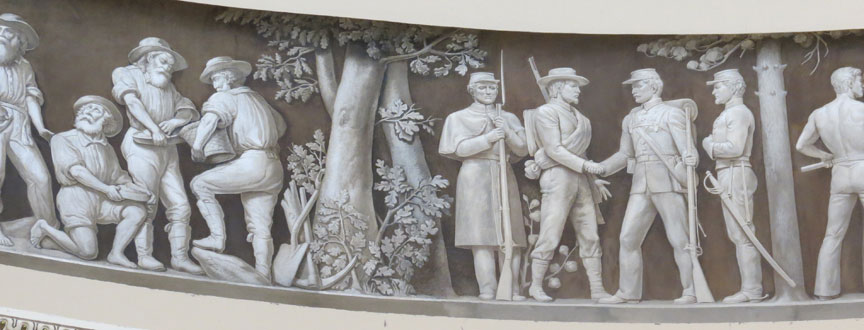
Peace at the End of the Civil War
This scene, the first of Allyn Cox's three panels, depicts a Confederate soldier and a Union soldier shaking hands at the end of the American Civil War, symbolizing reconciliation and reunification. The cotton plant and the Northern pine tree symbolize the South and the North
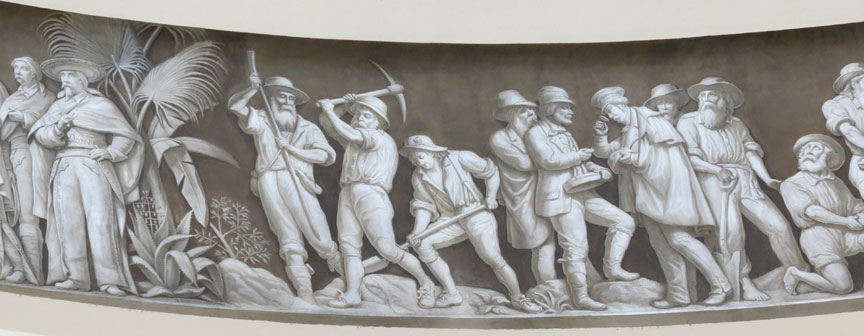
Discovery of Gold in California
Prospectors dig and pan for gold with picks, shovels, and other tools in this depiction of the California Gold Rush. In the center, three men (one possibly representing John Sutter) examine a prospector's pan. This was the last scene designed by Brumidi and painted by Costaggini
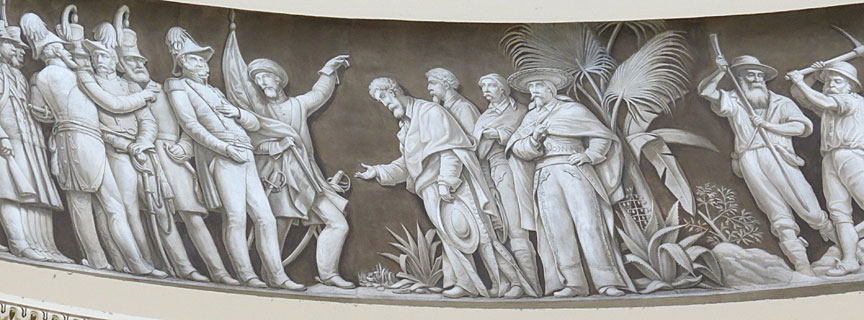
American Army Entering the City of Mexico.
U.S. Army troops led by Winfield Scott enter Mexico City after the fall of Mexico City, which ended the Mexican-American War with a decisive American victory. The 1848 Treaty of Guadalupe Hidalgo, which provided for the massive Mexican Cession of territory in what is now the Western United States.

Death of Tecumseh
This panel depicts the death of Shawnee chief and Indian Confederation leader Tecumseh at the Battle of the Thames in Upper Canada during the War of 1812.

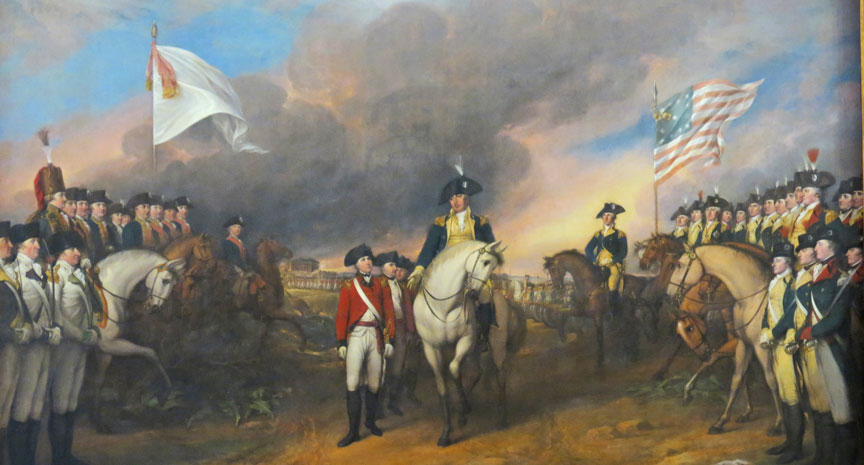
Surrender of Lord Cornwallis
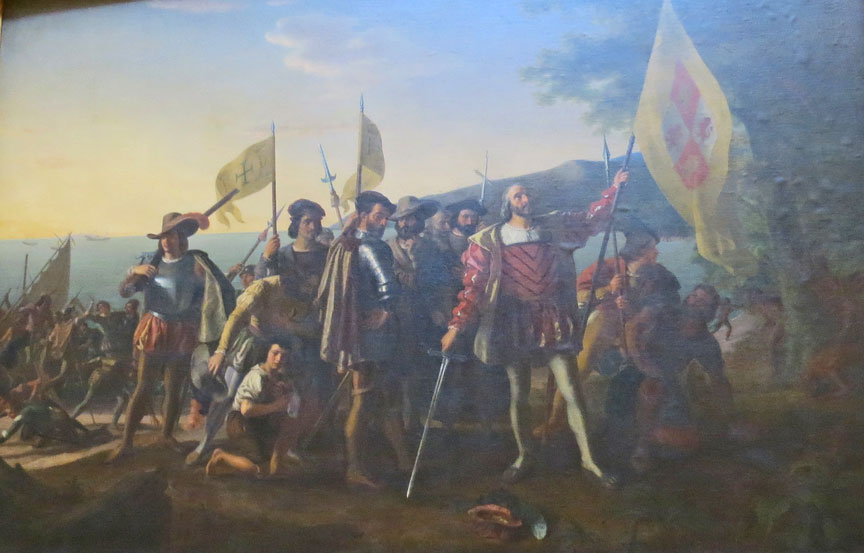
Landing of Columbus

Discovery of the Mississippi
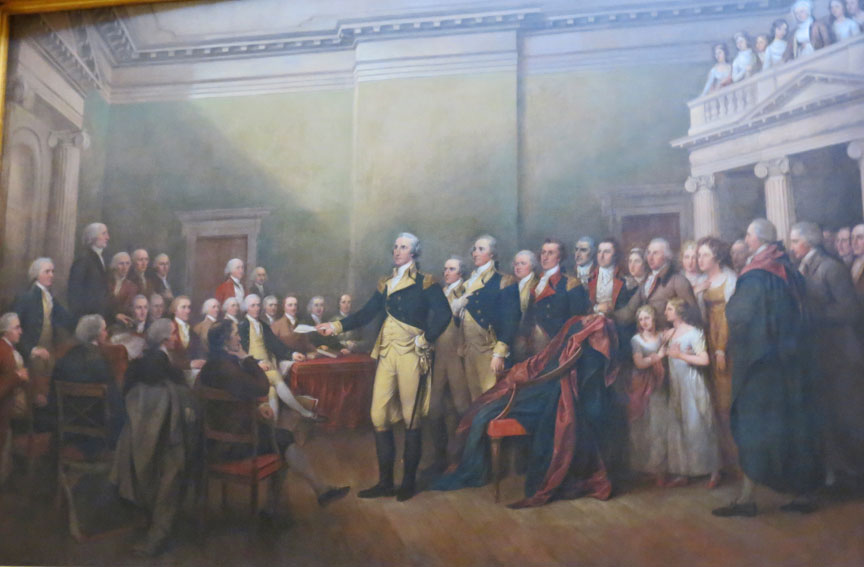
General George Washington Resigning His Commission

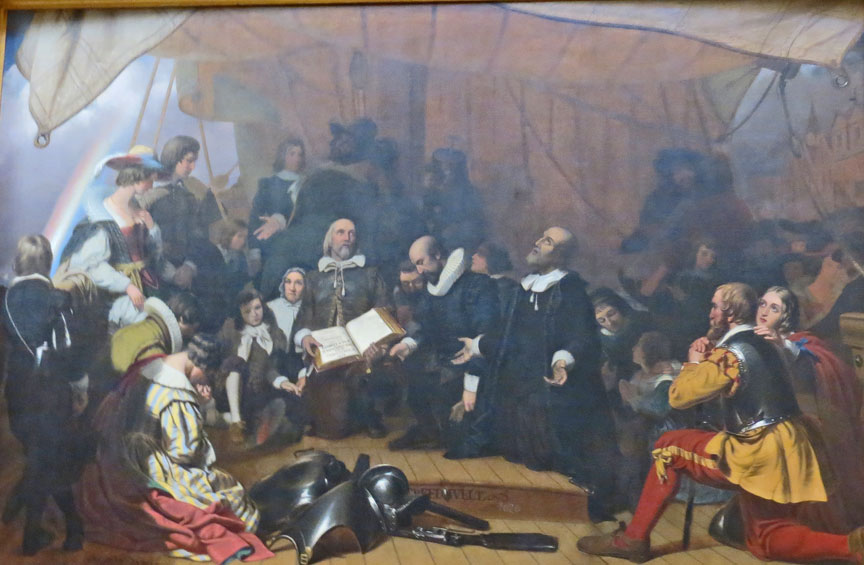
Embarkation of the Pilgrims
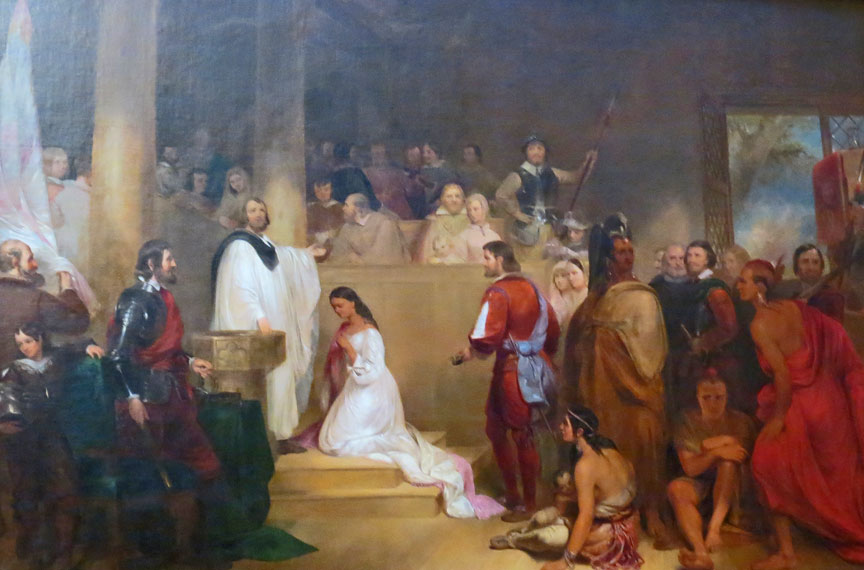
Baptism of Pocahontas
Dressed in white, Pocahontas kneels, surrounded by family members, including her father, Chief Powhatan, and colonists. Her brother Nantequaus turns away from the ceremony. The baptism occurred before her marriage to Englishman John Rolfe, who stands behind her.
